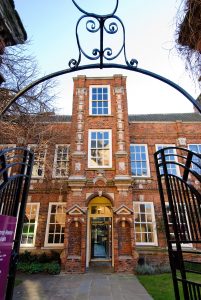Ian Streets, managing director of About Access, looks at how the heritage market can meet the needs of disabled customers
The balancing act between accessibility and authenticity has become one of the key tests for the ever-expanding tourism sector as it works to attract growing audiences that are increasingly diverse.
Those modern attractions built from scratch should find it relatively easy to meet the needs of disabled visitors by designing the requirements into the structure and the services from the outset. But properties dating back hundreds or even thousands of years usually present a more complicated scenario, as we have found through our work for Historic Houses.
This body represents the nation’s largest collection of independently owned historic houses and gardens, with a membership of more than 1,600 properties around the British Isles. Formerly known as the Historic Houses Association, its work includes promoting the properties to visitors, and we have an important part to play in that.
We provide advice to the owners and operators of the properties, based on our wide experience of improving the accessibility of all sorts of buildings and services from shops and offices to leisure centres and transport systems.
Our interest was ignited first and foremost by our desire to do what we can to remove the barriers facing disabled people in their everyday lives. Linked to that are the lessons for businesses – a category that in the modern age inevitably includes the members of Historic Houses – in developing their customer base.
We show people the commercial benefits of making it easier for more people to walk or ride through their doors or gates, and we explain the concept of the Purple Pound – the spending power of disabled people and their companions, said to be worth around £249bn every year.
But tapping into that market as the owners and operators of any historic property can be fraught with difficulty. The key issue is how you improve accessibility without destroying or significantly changing the features and character of the building, which are at the heart of its appeal to tourists.
The solutions vary between simple and straightforward or costly and complicated, and they usually require thinking outside the box, or even inside the box – like concealing a lift inside an adapted cupboard!
That was one of the modifications to Wilberforce House Museum, birthplace of anti-slave trade campaigner William Wilberforce, and it opened up most of the first floor to wheelchair users. The fact that other areas of the first floor are not fully accessible illustrates a lasting difficulty – the doors are too narrow for larger electric wheelchairs and in a listed building cannot routinely be widened.

Improvements to the frontage of Leeds City Museum were similarly innovative, and on a much larger scale, moving the rows of steps at the front of the building and creating a “shallow, smooth ramp” at the side, which has been welcomed by wheelchair-users as an excellent example, on arrival, of the high levels of accessibility throughout the building.
A cathedral we worked on demonstrated the day-to-day issues that can affect visitors to historic properties. Whatever the tourism appeal of this particular building, it presented clear problems for members of the congregation who used wheelchairs.
They were unable to access the pews, which were raised slightly on a plinth so the wheelchairs had to park at the end of the row, in the aisle or at the front of the pews. However, it was suggested that, provided the worshippers would still have good sightlines, an accessible location could be created for them by removing some of the pews and the raised plinth.
The idea was welcomed and discussions took place with the relevant bodies that grant permission, as they always should with historic properties – under no circumstances should work take place on historic properties without first getting approval.
There are various factors to consider, including that some modifications can be made to improve the accessibility of a building without taking away from the history. Buildings have to be used as much as possible and if you don’t improve accessibility, a building may not be used to its full potential.
It’s also important to remember that historic sites change, as do the features within. We did some work with English Heritage at Rievaulx Abbey, which has signs around the ruins to indicate particular features of interest. The signs themselves date back to the 1960s and have become part of the heritage of the site, not to be removed or destroyed.
But the historic nature of a site should not be used as an excuse to avoid doing anything. You just need to get the necessary consents before you start the work. If the consents are not forthcoming, that refusal can legitimately give you the confidence you need to present your arguments for not making changes, whereas cost alone would not be a good reason.
But even in those circumstances, you could still look at how you adapt your offering to make it more accessible. It might mean providing some sort of interpretation, such as video, to help people who cannot get to particular parts of the building or site, extending to the grounds and the approaches.
It’s about balancing the approach between conserving the historic environment and improving access, and it’s important to remember that the nature of the visitors varies because of the wide appeal that these properties need to generate and because disabled people are increasingly active and adventurous.
They do not want to see historic buildings presenting a sanitised view of the world. They want to get as close as they can to the history and the authenticity of the property and it’s good for everybody if the owners and operators can help them to do that.
Ian Streets advises public and private sector bodies and businesses on accessibility legislation, issues and best practice.

Ian Streets
Managing Director
About Access
Tel: 01482 651101
Please note: this is a commercial profile.













